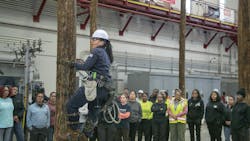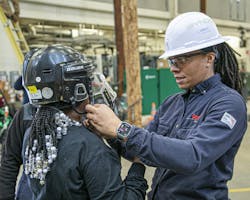ComEd Powers the Future with a Diverse Workforce
Listen to this Audio Story in the ICYMI Series for the Line Life Podcast
Illinois will move toward 100% clean and renewable energy by 2050 as part of its landmark Climate and Equitable Jobs Act (CEJA). For ComEd, the electric utility serving 70% of the state’s customers and communities, this will bring expanded solar and EVs and advancements in grid technology to support a low-carbon future — and all of this will require a skilled and diverse talent pipeline to move toward these goals. In fact, a recent ComEd-commissioned study finds that the clean energy transition will create as many as 150,000 jobs in Illinois by 2050.
As it builds its future clean energy workforce, ComEd is taking steps to reflect the vibrant communities it serves, including more than 9 million people from a variety of backgrounds, who speak more than 50 languages and live in both rural and urban areas.
“Diversity and inclusion are central to our efforts to ensure a strong and productive workforce that will power ComEd well into the future,” said Erin Howe, ComEd manager of operations planning and analysis. “As our near 6,600-strong workforce advances the clean energy goals of the communities we serve, we will continue our efforts of recruiting and building a highly skilled talent pool to meet the need.”
Here are four ways the utility is focusing on strengthening its workforce to meet clean energy goals.
1. Focus on trades training and STEM education.
ComEd has targeted efforts to reduce barriers and reach varied candidates through its award-winning trades training and STEM education programs, some of which offer utility pole climb training and test prep sessions for the Construction and Skilled Trades (CAST) exam, an industry-required test.
In 2018, ComEd entered an agreement with the International Brotherhood of Electrical Workers (IBEW) Local 15 to expand entry-level trades opportunities tied to CEJA and FEJA (Future Energy Jobs Act). Since then, ComEd has hired more than 1,000 construction workers and overhead helpers — those starting their journey to become future lineworkers. In July 2024, ComEd unveiled its seventh training center in northern Illinois to boost training opportunities across the communities it serves.
Illinois also has several top-rated colleges and engineering and STEM programs. “ComEd employs the best and the brightest, and through collaboration with a variety of local and regional partners, we’re able to recruit and open pathways for more people who have an interest in construction and the utilities to enter our field,” Howe said. “We’re also fortunate here in Illinois to be able to draw upon some of the best talent and one of the most educated workforces in the nation.”
2. Expand internal and external training programs.
The utility is taking a comprehensive approach to meeting future workforce demands, which includes growing both internal and external training programs offered in partnership with many organizations in its region, to ensure its employees and candidates have the skills needed to build the clean energy grid of the future.
“Within the company, we are continuing job rotations and cross-training to ensure current employees maintain a broad skillset and knowledge of the latest technology and industry requirements,” Howe said. “In addition, mentoring programs are offered to ensure employees have the support and sponsorship they need to navigate our company and the energy industry.”
ComEd is also upskilling local jobseekers and inspiring youth for future clean energy jobs through its suite of workforce development programs.
“We launched three new programs in 2023 which, along with our established job training and STEM education programs, reached more than 2,000 individuals,” Howe said. “One of the newest programs, the Power Up Academy, is a career training program designed to prepare more area men and women for in-demand technical roles in the energy sector without requiring a college degree. The program was accredited by the City Colleges of Chicago in November, meaning that past and future participants are eligible for up to a semester’s worth of college credits to help them advance their education and career in the engineering field.”
Since 2013, ComEd’s trades training program, the CONSTRUCT Infrastructure Academy, has graduated more than 900 members of the community and connected more than 70 percent of them to full-time jobs.
“These programs are successful thanks to the strong partnerships we’ve built with key community agencies, education organizations and sponsoring companies across our service region,” Howe said.
For example, Central States SER, a local non-profit, recently awarded ComEd the El Cambio Advocates for Change Award for its adult workforce programming.
“It’s a coalition of agency partners and potential employers, powered by the relationships cultivated within the community, that allow for local, rising talent to get connected to rewarding career opportunities,” Howe said.
3. Enhance recruitment to reach more women in the line trade.
Due to ComEd’s efforts to be inclusive in its hiring and recruitment processes, the utility has made considerable progress in bringing more women into the field.
“From kicking off all-female utility pole climb clinics, to creating safety equipment fitted for women in field positions, ComEd continues to invest in creating an inclusive work culture at a company where women reflect about half of all executive leadership roles,” Howe said.
Industry-wide, female participation in craft roles is 4.3 percent, according to the U.S. Bureau of Labor Statistics. In the last year, ComEd hired more women into entry-level field positions that lead to becoming a lineworker, representing a more than 70 percent increase in women in craft positions at the company in one year.
“This is just the beginning, and through our partnerships with local education and workforce agencies, as well as the International Brotherhood of Electrical Workers (IBEW) Local 15, we collaborate toward progress in not only bringing more women into the field but also setting them up for success in their careers,” Howe said.
Physical labor required in the field is a challenge encountered by all apprentices. For example, overhead line workers need to be able to lift 50 lbs. of equipment on top of their own body weight when climbing utility poles.
That’s why, in 2022, ComEd launched the first-ever all-female climb clinics where women who were interested in joining the overhead apprenticeship program could practice climbing utility poles, which is required to pass employment testing. Since then, ComEd has seen an increase in women applying for trades roles. This points to the success of the program’s effort to raise awareness among, but not limited to women, on the good-paying and impactful jobs within the trades through recruitment and outreach in partnership with IBEW Local 15.
4. Ensure inclusivity and safety by expanding protective equipment and clothing offerings.
As ComEd builds a talent pipeline to support the clean energy transition in Illinois, more women are joining the ranks of field workers ready to maintain and modernize the power grid. With safety as its utmost priority, this increase in different-sized frames prompted ComEd to look deeper into how safety gear can be improved to fit and protect women while working overhead.
Some of the safety equipment that must be worn by overhead lineworkers includes body belts and “climbers,” which are stirrups with gaffs that enable lineworkers to ascend, descend or secure their position on a pole.
Tim Griffin, an instructor at ComEd’s Chicago training center, recalled some female overhead students wearing loose-fitting climbers and having difficulty keeping the body belt in the desired location while ascending the pole.
“As we recruit and train more people to join the clean energy workforce, we need to innovate our equipment to accommodate a growing number of workers with varying body types to ensure the safety of anyone who is interested in becoming a lineworker,” he said.
A properly worn pair of climbers extend from the instep to below the knee, and climbing boots should fit snugly in the stirrups. The perfect fit can be difficult to achieve for people with smaller or narrower feet and below 5 ft, 5 in. in height. Since women are 5 ft, 3 1/2 in., on average, it’s more likely that they will have fit issues. Another key piece of safety equipment is the body belt that goes around lineworkers’ hips for support while off the ground. This belt has been designed for the male body since its introduction more than a century ago, even as other enhancements were introduced to improve comfort and safety.
Last year, ComEd commissioned shorter and narrower climbers from an equipment vendor, Buckingham Manufacturing, and received several sets for trainees across ComEd’s overhead training sites. ComEd’s safety team also worked closely with Buckingham to pilot a two-in-one body harness that combines shoulder and leg straps to ensure a secure hold on the worker while up high. Both male and female ComEd apprentices field-tested these prototypes between 2023 and 2024. Narrower climbers have been available for employees since June 2023, and as of December 6, 2024, ComEd employees can order a Safety-approved two-in-one body belt and harness.
Asianay Johnson, an overhead basic school apprentice for ComEd, says when she started the initial overhead qualification school, she was so small she couldn’t fit into the company-approved belts. When she was introduced to the harness, it allowed her to become more comfortable and confident in her climbing abilities.
“ComEd is leveling the playing field to career success in the overhead world by making the necessary modifications so that anyone, regardless of age, shape or size, can excel at being a proficient climber,” Johnson says. “The gender wall is coming down, and I look forward to seeing more women enter this line of work.”
Besides hardhats and safety glasses, one of the most important pieces of personal protective equipment (PPE) for field workers in the energy sector are flame resistant (FR) garments. FR clothing protects workers who may become exposed to an electrical arc flash or flash fire and are properly worn as the outer layer of clothes.
FR shirts, for example, are properly worn buttoned and tucked into pants, with sleeves rolled down. That’s why as more women join the trades workforce in the energy field, companies like ComEd must be able to provide comfortable workwear that will keep employees safe, regardless of their size, shape or gender.
In 2022, ComEd’s Safety team kicked off an FR committee, lead largely by craft employees, in close collaboration with the employee union IBEW Local 15, and fire-retardant vendor, Tyndale, to provide female field workers with an extensive collection of women’s FR clothing and work boots.
Upon providing employee feedback, Tyndale got to work right away. The company has since periodically sent new clothing for female field workers to test across the seasons and requests feedback for the continuous improvement of inclusive PPE.
“It’s not enough to provide the same PPE men wear in smaller sizes,” Howe said. “By offering a wide variety of clothing dimensions, we are catering to diverse frames, ensuring the best fit and comfort that’s essential for workers to stay safe.”
Note: To listen to a narrated version of this article for the Line Life Podcast in the ICYMI series, click here.
About the Author
Amy Fischbach
Electric Utilities Operations
Amy Fischbach is the Field Editor for T&D World magazine and manages the Electric Utility Operations section. She is the host of the Line Life Podcast, which celebrates the grit, courage and inspirational teamwork of the line trade. She also works on the annual Lineworker Supplement and the Vegetation Management Supplement as well as the Lineman Life and Lineman's Rodeo News enewsletters. Amy also covers events such as the Trees & Utilities conference and the International Lineman's Rodeo. She is the past president of the ASBPE Educational Foundation and ASBPE and earned her bachelor's and master's degrees in journalism from Kansas State University. She can be reached at [email protected].



